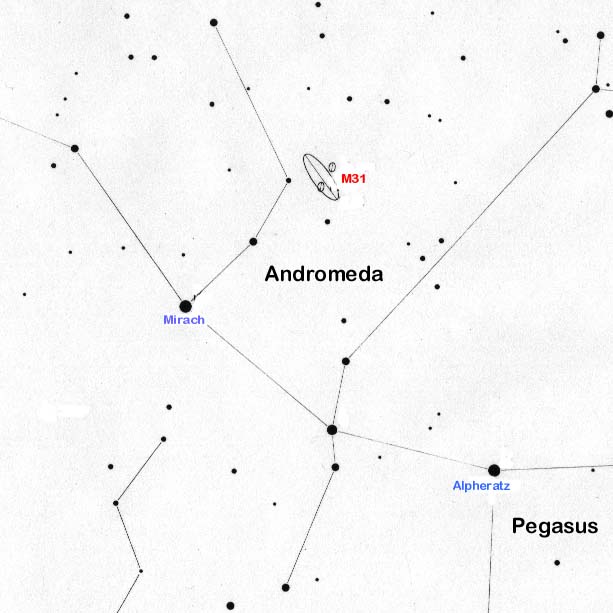![]()
![]()
M31, the Andromeda Galaxy, is among the most distant objects visible to the naked eye. M31 is a spiral galaxy, a star city shining with the brilliance of more than 200 billion suns. Despite its distance of about 2.4 million light-years, the Andromeda Galaxy is easily seen without optical aid from a typical rural location. When you find M31, bear in mind that the light you are seeing has been travelling through space for more than two million years, since before modern man walked the Earth.
Your search for M31 begins in Pegasus, the winged horse of ancient mythology. This region is often identified by an arrangement of four bright stars. Scheat, Markab, Algenib and Alpheratz form the Great Square asterism. All but one belong to Pegasus. Alpheratz, the star marking the northeast corner of the Great Square, actually resides in Andromeda. Andromeda is distinguished by two rows of stars arching to the northeast from Alpheratz. The bottom row features brighter stars, including Delta and Beta Andromedae. Beta Andromedae, more commonly referred to as Mirach, is the second star you encounter along Andromeda's southern row. Jump from Mirach to the nearest star in the second row. This is 3.9 magnitude Mu Andromedae and it is just 3.8 degrees from Mirach. Continue in the same direction for 3.7 degrees and you should glimpse a delicate, elongated patch of light. That's not a cloud. That's M31, the Andromeda Galaxy.
| Autumn Sky Tour: M31-The Andromeda Galaxy (Andromeda) RA: 00h 42.7m / DEC: +41° 16'.1 |

|
|

Home | About Cosmic Voyage | Getting Started | Deep-sky Observing | Planetary Observing | Astrophotography | Sketching | Glossary | Web Links
URL: http://www.cosmicvoyage.net
Layout, design & revisions © W. D. Ferris
Comments and Suggestions: wdferris1@gmail.com
Revised: February 10, 2002 [WDF]